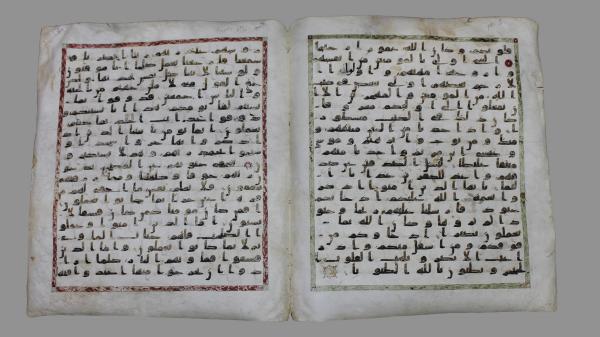Double Folio from a Qur'an
Artwork Details
- Title: Double Folio from a Qur'an
- Date: late 7th–early 8th century
- Culture: North African (Kairouan, Tunisia)
- Medium: Brown ink on vellum
- Dimensions: 19 5/16 × 9 in. (49 × 22.8 cm)
- Classification: Manuscripts
- Credit Line: Musée National d’Art Islamique de Raqqada, Kairouan
- Rights and Reproduction: Photo: Nizar Hamza
- Curatorial Department: Medieval Art and The Cloisters
Audio

545. Double Folio and Folio from a Qur'an
Michelle Al-Ferzly, Research Associate, The Metropolitan Museum of Art
NARRATOR: These sheets of parchment show that dividing lines between religions and regions are not always as defined as they may seem. You see two pages from an early copy of the Qur’an, the holy scripture of Islam, and another folio to its right. Michelle Al-Ferzly is a Research Associate for Byzantine art at The Met and catalogue contributor.
MICHELLE AL-FERZLY: These two folios each feature about twenty lines of Arabic script written in brown or black ink against parchment. The one on the left is framed with a band of red interlace, while the one on the right features a band of green interlace.
The other folio is much more colorful and dynamic. A really stunning feature of this page is the band of interlace that you see at the middle. The interlace includes this very elaborate geometric motif with red and green ink as well as blue. That kind of ornamental feature is really interesting to us because it is reminiscent of manuscript production from Egypt also in the medieval period.
NARRATOR: In the late seventh century, Arab Muslim armies seized North Africa from Byzantine control and established the region’s new capital in modern-day Tunisia, in Kairouan. Meanwhile, in Egypt, Coptic Christian monasteries persisted even under the new religious rule. And they all used animal-skin parchment, black ink, and the same decorative crosshatched motif you see on these Qur’an pages.
MICHELLE AL-FERZLY: Often these Islamic manuscripts and Christian Coptic manuscripts aren't looked at in tandem because they represent different religious traditions. However, they do come from the same region. And so even if the Coptic intellectual communities who were producing these Coptic manuscripts did not ascribe to the dominant religion in the region at the time which was Islam, they were still looking to similar motifs and similar materials that their neighbors were as well.